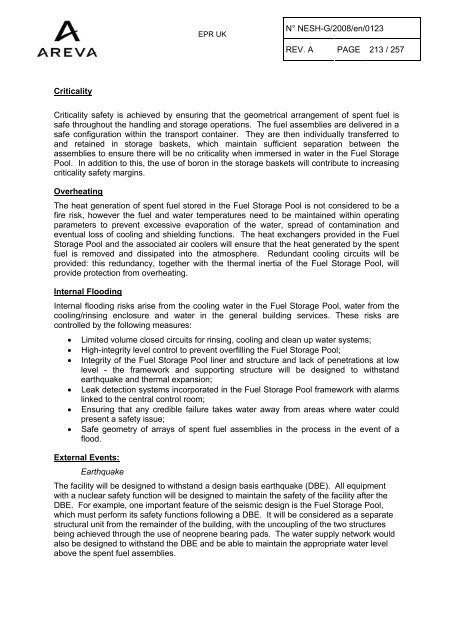Solid Radioactive Waste Strategy Report.pdf - UK EPR
Solid Radioactive Waste Strategy Report.pdf - UK EPR
Solid Radioactive Waste Strategy Report.pdf - UK EPR
Create successful ePaper yourself
Turn your PDF publications into a flip-book with our unique Google optimized e-Paper software.
<strong>EPR</strong> <strong>UK</strong><br />
N° NESH-G/2008/en/0123<br />
REV. A PAGE 213 / 257<br />
Criticality<br />
Criticality safety is achieved by ensuring that the geometrical arrangement of spent fuel is<br />
safe throughout the handling and storage operations. The fuel assemblies are delivered in a<br />
safe configuration within the transport container. They are then individually transferred to<br />
and retained in storage baskets, which maintain sufficient separation between the<br />
assemblies to ensure there will be no criticality when immersed in water in the Fuel Storage<br />
Pool. In addition to this, the use of boron in the storage baskets will contribute to increasing<br />
criticality safety margins.<br />
Overheating<br />
The heat generation of spent fuel stored in the Fuel Storage Pool is not considered to be a<br />
fire risk, however the fuel and water temperatures need to be maintained within operating<br />
parameters to prevent excessive evaporation of the water, spread of contamination and<br />
eventual loss of cooling and shielding functions. The heat exchangers provided in the Fuel<br />
Storage Pool and the associated air coolers will ensure that the heat generated by the spent<br />
fuel is removed and dissipated into the atmosphere. Redundant cooling circuits will be<br />
provided: this redundancy, together with the thermal inertia of the Fuel Storage Pool, will<br />
provide protection from overheating.<br />
Internal Flooding<br />
Internal flooding risks arise from the cooling water in the Fuel Storage Pool, water from the<br />
cooling/rinsing enclosure and water in the general building services. These risks are<br />
controlled by the following measures:<br />
· Limited volume closed circuits for rinsing, cooling and clean up water systems;<br />
· High-integrity level control to prevent overfilling the Fuel Storage Pool;<br />
· Integrity of the Fuel Storage Pool liner and structure and lack of penetrations at low<br />
level - the framework and supporting structure will be designed to withstand<br />
earthquake and thermal expansion;<br />
· Leak detection systems incorporated in the Fuel Storage Pool framework with alarms<br />
linked to the central control room;<br />
· Ensuring that any credible failure takes water away from areas where water could<br />
present a safety issue;<br />
· Safe geometry of arrays of spent fuel assemblies in the process in the event of a<br />
flood.<br />
External Events:<br />
Earthquake<br />
The facility will be designed to withstand a design basis earthquake (DBE). All equipment<br />
with a nuclear safety function will be designed to maintain the safety of the facility after the<br />
DBE. For example, one important feature of the seismic design is the Fuel Storage Pool,<br />
which must perform its safety functions following a DBE. It will be considered as a separate<br />
structural unit from the remainder of the building, with the uncoupling of the two structures<br />
being achieved through the use of neoprene bearing pads. The water supply network would<br />
also be designed to withstand the DBE and be able to maintain the appropriate water level<br />
above the spent fuel assemblies.

















